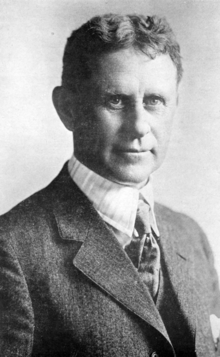Alexander Phimister Proctor
| Alexander Phimister Proctor | |
|---|---|

Proctor as depicted in the
Oregon Historical Quarterly, 1919 |
|
| Born |
September 27, 1860 Bosanquet Township, Ontario, Canada (then in the Province of Canada) |
| Died | September 4, 1950 (aged 89) Palo Alto, California |
| Known for | Sculpture and painter |
| Notable work | Bucking Bronco, Denver, Colorado (1920); Theodore Roosevelt, Rough Rider, Portland, Oregon (1922); On the War Trail, Denver, Colorado (1923) |
| Awards | Columbian Exposition, Designer Medal (1893); Académie Julien, Medal and Prize (1894); Paris Exposition, Gold Medal (1900); Louisiana Purchase Exposition, Gold Medal (1904); Architectural League of New York, Gold Medal of Honor (1911); Panama-Pacific International Exposition, Gold Medal (1915) |
Alexander Phimister Proctor (September 27, 1860 – September 4, 1950) was an American sculptor with the contemporary reputation as one of the nation's foremost animaliers.
Born in Bosanquet, Ontario, near the village of Arkona, Ontario, the son of Thirzah Smith (born 1832), herself daughter of a contractor on the Erie and Welland Canals, and Alexander Proctor (1822–alive 1904). The family left Canada in 1866 and moved to Iowa and then to Denver, Colorado, when Alexander was eleven. Growing up on the frontier, Proctor early developed into a skilled woodsman and hunter—interests that remained with him for the rest of his life. In his autobiography, Sculptor in Buckskin, he spends as much ink, and seems to be as excited about killing his first bear and elk as he is about obtaining his first major commission.
Along with his gun, Proctor took pencils and a sketching pad with him on his trips through the Rocky Mountains. As a hunter he always was careful to measure, draw, and sometimes dissect the animals that had crossed his gun sights. These early studies helped propel him to the position of one of the most sought after and respected animaliers of his day. He was fortunate to find an art instructor in the still rough and tumble Colorado, where his early drawings included big horn sheep, elk, bears, and the lynching of outlaw L.H. Musgrove, which occurred in Denver in November 1868.
In 1885 Proctor sold a homestead that he had acquired in Colorado and used the proceeds to move to New York City with the intention of studying art. He enrolled first in the National Academy of Design where he studied drawing and painting, and later, at the Art Students League of New York, where his interest in sculpture came to the fore. His ability to capture animals in action, garnered in part from his days tracking them, coupled with his interest in all things Native American, opened a niche for Proctor, one that he parlayed into a long, successful career.
...
Wikipedia
